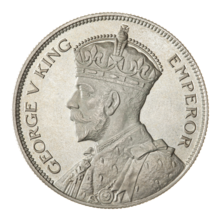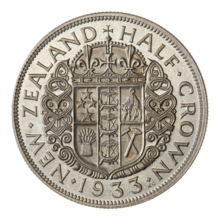New Zealand | |
| Value | 2½s (£NZ) |
|---|---|
| Mass | 14.14 g |
| Diameter | 32 mm |
| Edge | Milled |
| Composition | 1933–1946: 50% silver, 50% quaternary alloy 1947–1965: cupronickel (75% copper, 25% nickel) |
| Years of minting | 1933–1965 |
| Obverse | |
 | |
| Design | Crowned bust of George V |
| Designer | Percy Metcalfe |
| Reverse | |
 | |
| Design | The coat of arms of New Zealand, surrounded by Māori carvings. |
| Designer | George Kruger Gray |
The half-crown is the largest of five denominations of New Zealand pound coinage first issued in 1933. Introduced due to shortages of comparable British silver coinage following the devaluation of the New Zealand pound relative to the pound sterling, the coin measures roughly 32 mm (1.3 in) in diameter. It was equal to thirty pence, two and a half shillings, or an eighth of a pound.
Designed by George Kruger Gray, the coin's reverse features the New Zealand coat of arms surrounded by Māori wood carvings. Quickly approved by design committees in Britain and New Zealand to resolve the local currency shortage, the coin was the first denomination of New Zealand coinage to enter circulation. It was initially struck by the Royal Mint in .500 fineness silver, but was produced in cupronickel from 1947 onward. A commemorative issue, celebrating the centennial of the Treaty of Waitangi, entered circulation in 1940.